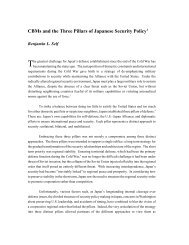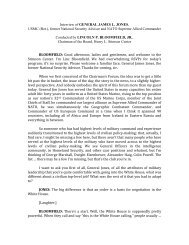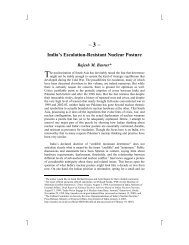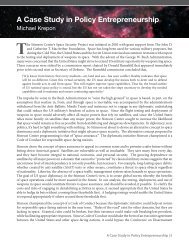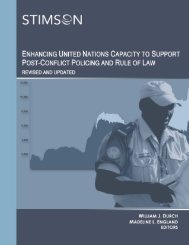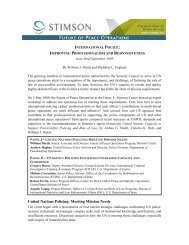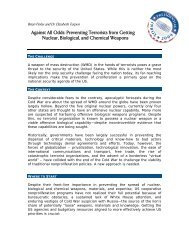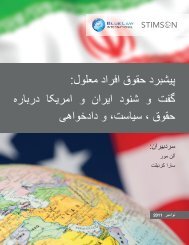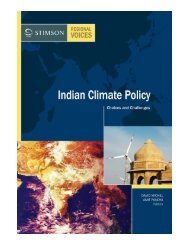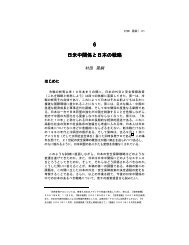Islam and Politics - The Stimson Center
Islam and Politics - The Stimson Center
Islam and Politics - The Stimson Center
You also want an ePaper? Increase the reach of your titles
YUMPU automatically turns print PDFs into web optimized ePapers that Google loves.
34 | Role of Religion in Afghan <strong>Politics</strong>: Evolution <strong>and</strong> Key Trends<br />
making up the rest (including a small minority of Ismailis comprising a few thous<strong>and</strong> people<br />
in the northeastern provinces). <strong>The</strong>re are only tiny numbers of Sikhs, Hindus, <strong>and</strong> Zoroastrians<br />
living in the country. Afghan society is religiously conservative, <strong>and</strong> rulers have<br />
traditionally maintained close relations with the clergy. Rulers who instituted reforms that<br />
were seen as un-<strong>Islam</strong>ic by the clerics <strong>and</strong> society often lost their popular support. Thus,<br />
the current administration of President Hamid Karzai has been wary of putting a secular<br />
face to the government. It has especially taken care to appear sensitive about protection of<br />
madrassas <strong>and</strong> shrines.<br />
Some efforts were made early in the current peace process to include religious voices in<br />
politics. In 2001, the role of the religious establishment was formally recognized by its<br />
inclusion in the Bonn meeting that articulated the plan for governing the country following<br />
the ousting of the Taliban by the United States. In 2002, President Karzai reorganized the<br />
Shura-e Ulama (a council of religious scholars that advises on sharia law <strong>and</strong> other matters)<br />
<strong>and</strong> asked it to issue a religious edict that invalidated the Taliban’s call for holy war<br />
against international coalition forces <strong>and</strong> the Afghan government. Since then, the engagement<br />
of religious figures in elections (2004) <strong>and</strong> constitutional arrangements (2005) has<br />
continued.<br />
When he came to power in 2002, President Karzai inherited the madrassas that were built<br />
during the pre-Soviet <strong>and</strong> Taliban periods. In addition to these, the new government established<br />
a few madrassas as “an essential counterweight to the privately run madrassas,” in<br />
spite of intense pressure from the international community to refrain from doing so. [3]<br />
<strong>The</strong> role played by the Iranian <strong>and</strong> Pakistani madrassas in the Afghan resistance against the<br />
Soviet Union shaped the state policy in Afghanistan toward religion <strong>and</strong> its role in politics.<br />
<strong>The</strong> government was concerned that private madrassas in Afghanistan would proliferate<br />
through funds <strong>and</strong> charities in the country, as well as from individuals <strong>and</strong> groups abroad.<br />
Certain segments of the Karzai administration also believed that Afghan religious scholars<br />
were radicalized in madrassas in neighboring countries, especially in Pakistan <strong>and</strong> Iran.<br />
<strong>The</strong>se segments of the administration felt the best way to stem the prospect of militant tendencies<br />
was to establish peaceful religious institutions domestically, thus minimizing the<br />
need for Afghans to go abroad for religious education. [4]<br />
Key Trends in <strong>Politics</strong><br />
Historically, several broad trends can be described. Several of them reflect the political<br />
<strong>and</strong> social realities of various periods during the last century, with the influence of religion<br />
in Afghanistan’s politics declining steadily until the Soviet invasion, resurging during the<br />
jihad against the Soviets, <strong>and</strong> receding after the ouster of the Taliban.



